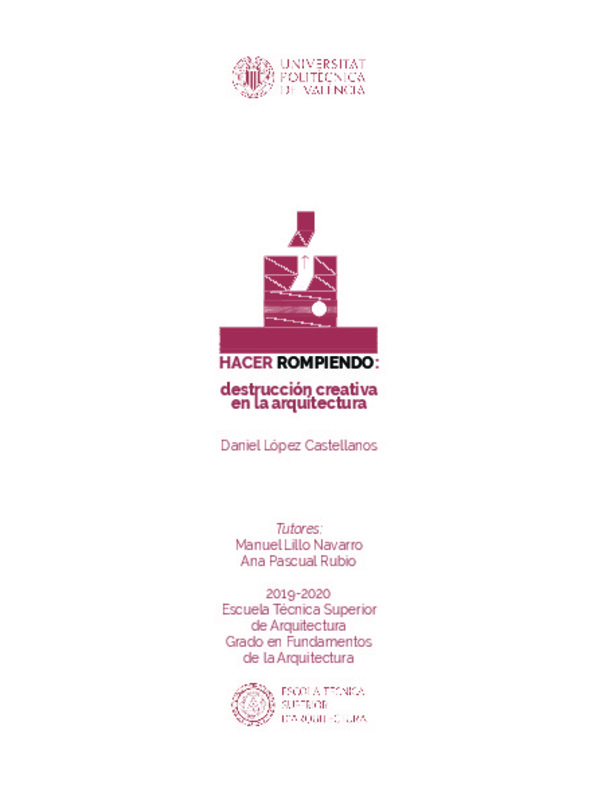|
Resumen:
|
[EN] The shortage of unaltered places collide with the large number of the ignored ruins. The forgotten matter , which is the result of a destructive action that generates a rejection of value for society, is being more ...[+]
[EN] The shortage of unaltered places collide with the large number of the ignored ruins. The forgotten matter , which is the result of a destructive action that generates a rejection of value for society, is being more and more used in the creative processes by artists.
The reflections on the destruction and ruin have been present throughout history, experiencing an exponential growth in times of crisis; something that can be observed in the Roman ruins of the eighteenth century, in the war ruins of the twentieth century, and even today, in the new real estate ruins of the twenty-first century.
Within these reflections, the architectural practice has been aware of the proliferation of derelict, destroyed or wasted spaces. For that reason many projects have answered to this imbalance through their own destruction by creating new architecture that dialogues between the past and the present of the place. Therefore, in many works, such as Gordon Matta-Clark's, Lady Allen of Hurtwood's or Henrich Tessenow's, space is enhanced and through the reuse of destruction and light destructive actions, where creativity plays a fundamental role.
From this perspective, the aim of the study focuses on the gathering and analysis of creative methods, linked to destruction in architecture, in order to demonstrate that architecture is also made by breaking.
[-]
[ES] La escasez del lugar inalterado contrasta con la abundancia de la ruina ignorada. Cada vez surgen más artistas que incluyen en sus procesos creativos la "materia olvidada", habitualmente infravalorada por la sociedad, ...[+]
[ES] La escasez del lugar inalterado contrasta con la abundancia de la ruina ignorada. Cada vez surgen más artistas que incluyen en sus procesos creativos la "materia olvidada", habitualmente infravalorada por la sociedad, fruto de sucesivas acciones destructivas. A lo largo de la historia, la reflexión sobre la huella del paso del tiempo en la arquitectura o la belleza de la ruina ha sido una constante, con especial auge en momentos de crisis social. Así ocurre en el siglo XVIII con la mirada retrospectiva hacia las ruinas romanas, en el siglo XX con las ruinas tras las devastadoras guerras, o en la actualidad con las nuevas ruinas inmobiliarias, derivadas de la "crisis del ladrillo". Dentro de esta reflexión, la práctica arquitectónica ha sido consciente de la proliferación de edificios y de espacios inacabados, destruidos o abandonados. Por ello, muchos arquitectos han querido dar respuesta a este contexto, utilizando las propias ruinas como argumento de proyecto, para crear nuevas arquitecturas donde pasado y presente conviven, estableciendo un estimulante diálogo. Así pues, en muchas obras, como las de Gordon Matta-Clark, Lady Allen of Hurtwood o Henrich Tessenow, el espacio se potencia y a través de la reutilización del destrozo y de leves acciones destructivas, donde la creatividad juega un papel fundamental. Desde esta perspectiva, el presente trabajo tiene por objeto el análisis crítico de diversos casos representativos de la arquitectura, con el objetivo de identificar las estrategias de proyecto que permiten a sus autores integrar arquitecturas degradadas o derruidas, para dar un uso a lo que ya hay y crear, a su vez, un vínculo sugerente con la memoria y la cultura de los lugares.
[-]
|







